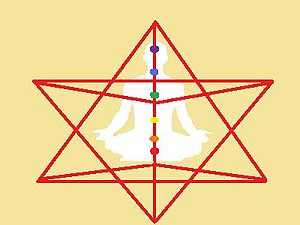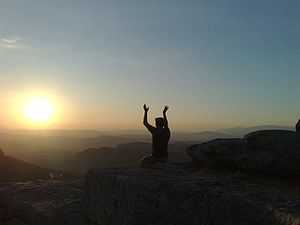God/Nils/Spirituality
< God < Nils
Spirituality is a way of working on oneself and his mind (spirit). The goal is to develop qualities such as inner peace, universal love, happiness and enlightenment. You can go the spiritual path alone or in a community. The focus is on inner experiences and less on outward rituals.
Through spiritual techniques such as mental work (positive thinking) and meditation one can come into contact with a higher level of consciousness (God consciousness, unity consciousness). One sees the light in the world, in himself and in his fellow man. If you get inner happiness you can also see the positive in the outer world. If you have love in yourself you can feel the love of the world.
Wikipedia: Spirituality can refer to an ultimate or an alleged immaterial reality; an inner path enabling a person to discover the essence of their being; or the deepest values and meanings by which people live. Spiritual practices, including meditation, prayer and contemplation, are intended to develop an individual's inner life; spiritual experience includes that of connectedness with a larger reality, yielding a more comprehensive self; with other individuals or the human community; with nature or the cosmos.
Christian Spirituality

Christian spirituality refers to a specific form of spirituality, which is centered in the personal relationship with Jesus Christ. It is tied back to biblical spirituality and early Christian practices. These include piety, asceticism and mysticism. Christian spirituality uses techniques such as contemplation, reading the Bible, prayer, charity, retreats, pilgrimages, sacred music; but the most important point is grace. Christian spirituality encompasses not only religious rituals, but is expressed by the spirituality of everyday life. Even small things can have a religious significance. It is important to understand the whole day as a spiritual happening and to grow spiritually through all things.
Buddhist Spirituality
The spiritual goal of Buddhism is enlightenment (moksha). There are many different methods and ways to this goal. The main path to enlightenment as the Buddha teaches is the Eightfold Path. An essential part is the practice of meditation. The best known buddhist meditations in the West are Vipassana and Zazen. Both schools teach the non-judgmental and unintentional awareness in the here and now, without being attached to thoughts, feelings or emotions.
Hindu Spirituality

Hinduism is composed of different directions with different schools. Most believers assume, however, that life and death is an ever-repeating cycle (samsara). They believe in reincarnation. The gurus in Hinduism are different. The Dalai Lama said that you should carefully examine each master. (Dalai Lama: Dzogchen, page 40)
Islamic Spirituality
The Pillars of Islam are the five basic acts in Islam, considered obligatory for all believers. The Quran presents them as a framework for worship and a sign of commitment to the faith. They are (1) the shahadah (creed), (2) daily prayers (salat), (3) almsgiving (zakah), (4) fasting during Ramadan and (5) the pilgrimage to Mecca (hajj) at least once in a lifetime. An important spiritual way of islam is the sufism.
New Age Movement
The New Age movement is a Western spiritual movement that developed in the second half of the 20th century. Its central precept is drawing on both Eastern and Western spiritual and metaphysical traditions and then infusing them with influences from self-help and motivational psychology, holistic health, parapsychology, consciousness research and quantum physics. It aims to create a spirituality without borders or confining dogmas that is pluralistic. Another of its primary traits is holding to a holistic worldview, thereby emphasising that the Mind, Body and Spirit are interrelated and that there is a form of unity throughout the universe. It further attempts to create a worldview that includes both science and spirituality.
The Five Basic Spiritual Techniques

Spiritually, humans can be compared to onions. Tensions and inner conflicts (inner stress) must be dissolved layer by layer. When one layer is peeled away, the next quickly appears at the surface until the inner core is revealed. At this point, a lasting inner joy is found. Inner joy appears in a person when the tensions (Samskaras) in body and soul have been dissolved. We need exercises for the body (Yoga, Tai-Chi.) and for the soul (meditation, reflection, positive thinking).
Buddha developed a very simple yet genius practice. This consisted of “sitting, going, and thought practice.” You need body work (Yoga, walking), mental work (reflection, reading, praying, mantra) and meditation (sitting or lying). And everything in balance, in the right moment and with the right technique. When one varies one’s activities between body work, mental work and meditation, the inner conflict and tension will go away. When a person only meditates, the spirit becomes dull and listless. Routine movement makes the spirit clear, keeps the body healthy and gives the person inner energy. If you only do Yoga Asanas, the mind is restless. Inner happiness comes from inner peace. If the body is kept very quiet, you can get into deeper dimensions of meditation.
In addition to periods of sitting and relaxing in combination with movement, working with the thoughts is important in getting rid of inner conflict. A spiritual person should develop his or her thoughts with love, wisdom, and self-discipline. He or she should learn to bring the thoughts into stillness.
This basic model of stress resolution can be extended to the way of the five activities. The five activities are: reading, walking (or doing Yoga Asanas), Meditation (lying or sitting), Charity (Karma Yoga), and to enjoy life.
Karma Yoga opens the heart, gives inner power, and develops the consciousness towards all-encompassing love. All the different kinds of Yoga is excellent practice to reduce stress for working people.
The fifth activity consists of enjoying life. We should bring joy into our lives. That opens our hearts, and brings light inside us. Everyone is predisposed towards something. You can listen to music, eat something delicious, read a good book, watch a movie, find time for your favorite creative hobbies, and so forth. It is important though, to pay attention to the amount with which we busy ourselves with enjoyment. Too much of a good thing is not a good thing, too little makes life sad.
Also, too much direct contact with other people during the development of inner happiness should be avoided. A yogi should find out how much contact with others is good for him or her. At a certain point, physical rest can cause the energy of a person to go inward. The person no longer has to direct oneself towards outer activities, and puts more worth on the inner spiritual cleansing, the dissolving of inner conflict, and the development of inner happiness. This turning point must be discovered by each yogi for him or herself. It is difficult to find and hold onto. Life energy tends towards an excess of activity or towards dullness. Both need to be avoided with daily exercised self-discipline. When we keep inner calm, inner happiness appears. We can develop our true selves, and our sense of life.
Swami Shivananda (also written Sivananda) lived from 1897 to 1963 in India. He was one of the greatest Indian Saints of modern time. By profession he was a doctor. He taught the yoga of the trinity (Trimurti Yoga), the combination of Hatha Yoga (spiritual exercises), Karma Yoga (work for a happy world) and Master Yoga (daily connection with an enlightened master). He pushed for the cooperation of the religions. According to Swami Sivananda, enlightenment occurs via relaxation, practice, and love. When a Yogi or Yogini lives in an area of peace, he or she is already halfway there. The second half is tackled with spiritual practices. In order to pass through the gate to a life in light, all-encompassing love must be at the heart of the seeker of enlightenment. When a Yogi lives for the happiness of others, then the ego can be dissolved. When the ego disappears, the person is in light. Individuals who reach this point relax so deeply into their souls that the energy of happiness awakes from within.
Yogis know when and what technique they need"". When the body is dull and lacking energy, the Yogi goes for a walk. When he or she feels restless, he or she practices Yoga or meditates. When the spirit seems to rebel against the spiritual way, a book on spiritual topics helps to bring back the conviction towards enlightenment. A Yogi senses the inner conflict and uses the proper techniques to dissolve the tension; that is usually what the body and soul does not want at this moment. Wherever the neurotic tendency to feel repelled towards, something is usually the way to the light. On the other hand, we need sometimes to give the body and soul what they would like, otherwise tension is built. The way to happiness requires a lot of wisdom, inner knowledge and sensitivity.
The Unity of All Religions

(Quote from http://knol.google.com/k/nils-horn/yoga-basic-knowledge-and-exercises/d0nwq0okqs4d/34 )
Yogi Nils: Enlightenment is the center of all religions. The unity of all religions is an important goal towards building a happy world. The communication between religions is important, even when it’s sometimes difficult.
Anand: It is obvious that not all religions teach the same. Buddha taught that God and the soul don’t exist. Hinduism alleges the opposite.
Yogi Nils: Dear Anand, our discussion clarifies many basic things.
1. There is only one God. There is only one highest reality. There is only one truth. Varied religions are helpful so that one can discuss the ultimate truth. We can only comprehend that once we have attained enlightenment.
2. I have experienced that there is such a thing as reincarnation. I have seen my earlier life.
3. Buddha saw his earlier lifes once he became enlightened.
4. The Buddhist teachings only make sense when we consider the reality of rebirth. Why should you work towards enlightenment through the centuries when so few reach the goal? Most people would squander their lives if they couldn’t take the fruit of their striving into the next life. In Yoga, a Yogi resumes his practice from life to life until he has reached the goal of enlightenment. In this way, all spiritual people reach their goal at some point.
5. The earlier lives reveal themselves only after a certain point along the way. A human can be enlightened on a lower level, and despite this have no contact with his earlier life. For this reason, even some enlightened individuals may allege there is no such thing as reincarnation.
6. There is a lot of confusion among the religions of the world. I am of the opinion that all fully enlightened masters like Buddha, Jesus, Swami Shivananda, Amma, and Mother Meera see things the same way, they simply express them differently.
7. I am for freedom of faith and opinion. I allow for the plurality of opinions and religion. I accept Atheists. I can deal with the idea of an atheistic Buddhism. I am for the unity of all religions. It means that all religions should work together for a better world and for a world of love, peace, and truth.
8. Properly understood every concept of God leads us to inner peace and universal love. I wish a world of love and peace and not a world of perpetual wars of religion. I don´t want that the religions fight each other, but that they love and support each other.
Mountain of Religions

There were five people who sought God. One was an atheist, an other a Christian, the third a Yogi, the fourth a Muslim, and the fifth a Buddhist. One day the five seekers came to a large mountain. Up on the mountain shone a bright light. The atheist said: "This is the sun." The Christian said: "This is God." The Muslims gave it the name of Allah. The Buddhist thought it was the Nirvana. The Yogi called it Brahman (the higher reality).
The five-seekers debated long about the light, the happiness and God. The atheist insisted that there is no God. The Buddhists did not believe in a personal God. Which the Muslim and the Christian contradicted violently. The Yogi surprised his friends by stating: "This question cannot be clarified by an unenlightened man. We all must get enlightenment, then we will understand what God is." The five seekers had a long talk about God. They learned about their respective viewpoints. The talk was a great enrichment for all. But they could not come to a final result. They therefore decided to climb the mountain and to investigate the light exactly. There were many paths leading up the mountain. Everyone rose up on his own path.
When everyone had arrived at the summit, they decided to enter into the great mystery. They took each other by the hand and went into the great light. They passed through a great darkness (the ego resolution) and found themselves in God (transcendence). They stayed some time in God and then went back into the world of matter (the duality of things) . In God all had been speechless. But now their minds began to work. Excited, they told each other about their experiences. The Yogi felt God as happiness (peace-unity consciousness-bliss), the Christian as universal love, the Buddhist as inner peace, the Muslim as a great power and the atheist experienced God as a higher truth. The Muslims got the word "Allah", the Christian the word "God", the Buddhist the word "Enlightenment", the Yogi "Sat-Chit-Ananda" and the atheist "Unity". If they thought their particular word, they could immediately go back into the light. The word was their personal key to entry into the great mystery. Anyone who has met God, can come with the power of the memory and his personal mantra again into the state of enlightenment.
They decided to end their conflict and prefer to concentrate on the spiritual practice. They lived many years together on the mountaintop. They read their scriptures, meditated, made pilgrimages every day to the mountain summit and met once a week to a joint celebration. One day all arrived in the permanent light. And the great light transformed them. They saw the light in all beings and all things of the world. They realized that we are all brothers and sisters. They realized that only love, peace and happiness are important. They left their mountain, came back into the world of men and built up together a happy world. May we stop all religious wars in the world. May we build a golden age of love, peace and happiness on earth. May the light, the love and the truth always be with us.
Computer Meditation

A guided meditation on the computer is a fast way of relaxation. Through simple yoga movements associated with positive sentences you can dissolve inner blockages and recharge your mind positive. Get peace, power, love and happiness in five minutes.
Steps
- Visualize yourself as a Buddha (Shiva) or Goddess of Love. Think or speak the mantra: "Om Buddha of Love. Om Goddess of Love." Get the male and female enlightened energie.
- Send light (happiness, peace, love) to all beings: "I send light to ... (name). May all people be happy. May the world be a happy."
- Connect yourself with the Enlightened (Saints) or God: "Om all enlightened masters. Om God. I beg for guidance and help on my way.."
- Get the inner peace: "I take things as they are. I flow positive with my life."
- Calm your mind and speak (or think) one minute the mantra: "Om Shanti. Om peace."
- Stop one minute every thought.
- Relax.
- Find a positive sentence: "My positive sentence is ..."
- "Forward with love, peace, happiness and strength. Be a victor in your life. God bless you."
Tips
- The Computer meditation is aimed at people of all religious denominations. It may also be practiced by atheists. Take the sentences that fit for you. You can also rephrase the mantras and make them suitable for you. You can define God in your own way as a supreme being, as cosmos or a cosmic power (life power). You can omit the mantra "Om God" if it does not fit for you.
- The essence of spirituality is to build up inner strength, peace, love and happiness. Your inner energy can be awakened by positive visualizations in connection with mantras (positive statements, prayers).
- Inner peace arises if you put your mind to rest. For this purpose we will first use the mantra "Om Shanti. Om Peace." Then we stop for a minute every thought. Finally, it is good to linger in the relaxation for some time. In this final phase, it unfolds its healing (harmonizing) effects.
- On the spiritual path you're only successful if you always act in close contact with your personal truth and with a good feel for yourself. Practice the computer meditation therefore so that it fits for you personally and is good for you.
---> Video: Computer Meditation (Meditation for love, peace, happiness and power)
See also
| | Wikibooks has a book on the topic of God and Religious Toleration. |
- A yogi life
- Meditation
- Relaxation techniques
- Spiritual Almanac
- Yoga
- Yoga oracle
- Amitabha oracle
Videos
- Dalai Lama -- purpose of our life
- Dalai Lama Finding Purpose in Life
- Dalai Lama - Why meditate?
- Computer Yoga
- Computer Yoga for Advanced (Video with breathing exercises)
- Computer Meditation (love, peace, happiness and power)
- Meditation video (6 min.) Relax with a guided meditation with beautiful music.
- Karunesh - A Journey Of The Heart (new age music)
External links
- Download Wikibook Yoga with Yoga Oracle in various formats (PDF, Epub, Kindle).
- Yoga, God and Enlightenment (2009)
- Yoga Basic Knowledge and Exercises
- Spirituality (University of Maryland Medical Center)
- Spirituality and Spiritual Healing in Modern Word
- Spirituality and mental health (Royal College of Psychiatrists)
- University of Minnesota's Center for Spirituality & Healing
- Spirituality in the New Age